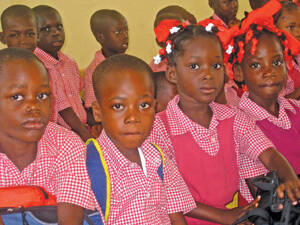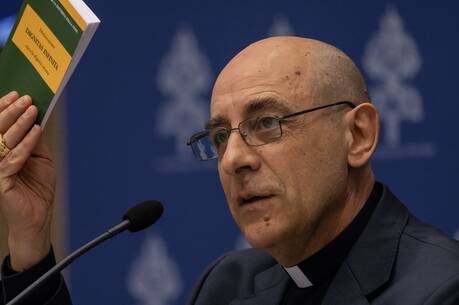Something new is happening in Chad and Haiti—actually something quite miraculous—and third-world Francophone educators are beginning to take notice. Jesuits in Mongo, Chad and Port-au-Prince, Haiti, have recently started Foi et Joie schools, after having formally affiliated themselves with Fe y Alegría, an international system of education emanating from Caracas, Venezuela. Both terms, one French and the other Spanish, mean the same: faith and joy.
Just before 7 a.m. on any weekday school morning in Mongo, a town of 20,000 inhabitants located in central Chad, small bands of students—boys casually dressed in black pants and white shirts and girls in long white laffafi and black headscarves—make their way slowly to the local lycée. As they cross one or more of the town’s main roads, they all but disappear from sight as swirling clouds of dust envelope them. They accept this environment as normal. In this part of Chad during the dry season, which lasts from November to June, water is extremely scarce. In particularly dry times, bleached-white cattle skeletons lie about the desiccated fields. The omnipresent whirlwinds of dust, tossed 20 feet into the air, are caused mainly by speeding passenger buses and overburdened cargo trucks.
If students in Mongo learn to survive in the forbidding environment of the sub-Saharan regions, those in Port-au-Prince have the equally daunting task of coping with life after the earthquake on Jan. 12, 2010. In those few minutes the lives of some three million Haitians changed, and the architectonics of the city would never be the same. The landmark presidential palace and both the Anglican and Catholic cathedrals still lie in ruins, as if nothing has been done in the last two years. The Jesuit-built Villa Manrèse, an imposing retreat house that the former-dictator François (“Papa Doc”) Duvalier took over when he expelled 18 Jesuits in 1964 for promoting issues of faith and justice, now resembles nothing more than an empty parking lot—with not one tiny stone on another!
While Haitian refugees continue to live in fetid, cholera-prone, makeshift camps throughout the city, they do not see progress on the structural and social changes that are so desperately needed. Financial aid poured into Haiti after the earthquake, but it is difficult to track the monies accurately. Before Christmas 2011, for example, the Clinton Bush Haiti Fund made a $914,000 grant to Quisqueya, a fairly new university in Port-au-Prince, to develop both current and future business leaders. This fund notes that the total value of damage caused by the earthquake is estimated at about $8 billion, of which approximately $5.5 billion was lost by the private sector. The United States spent $1.1 billion on immediate post-quake relief, according to an Associated Press release (Sept. 29, 2010), yet not one cent of the $1.15 billion promised in March 2010 by the United States for rebuilding had reached Port-au-Prince by the time the AP article was written. And less than 15 percent of reconstruction pledges from 50 other countries ($686 million of almost $8.75 billion pledged for 2010-11) had arrived. Thus the crucial question needs to be asked: What priorities should be established to bring about a transformation of the Haitian landscape and mindscape?
Education by Notes and Rote
As Paul Farmer, a physician and the chairman of Harvard Medical School’s Department of Global Health and Social Medicine, notes in his book Haiti After the Earthquake (2011), “Human capital had long been Haiti’s chief asset, and getting children and young people into safe schools that offered modern pedagogy was a top priority.”
There is no need to remind the children of Haiti of the importance of education. Yet, for those who do attend school, the days are filled with a simple, robot-like task: assiduously copying sentences and numbers from the blackboard into their notebooks. They will later memorize what they have written while daylight is still available. In both Haiti and Chad, educational pedagogy has remained the same for decades, part of a way of life deeply entrenched in all too many schools. Students show up for class; teachers write their lessons on the blackboards; and then students twist and angle about to see what has been written. Creativity is rarely expected or demanded. Meticulous penmanship and full notebooks pass as signs of academic achievement.
What is often forgotten is that Haitian and Chadian students have names, come from specific families and aspire to acquire the best of what their cultures and societies can offer—particularly an education that makes such students competitive locally, nationally and, God willing, internationally. Some religiously sponsored schools, like the exemplary Saint Louis de Gonzague school, run by the Brothers of Christian Instruction in Port-au-Prince, and the Chadian, Jesuit-sponsored Charles Lwanga School in Sarh, have been innovative on many fronts. But these are the exception. Overall the educational system in both countries has long needed innovative forms of pedagogy. That task poses linguistic obstacles for populations that officially speak myriad local languages in addition to Arabic/French in Chad, or Creole/French in Haiti.
Chadian and Haitian Jesuits and their lay counterparts are convinced that seeds planted in 1955 by José María Vélaz, S.J., a professor at the Andres Bello Catholic University, and his friend, Abraham Reyes, who turned his own home into a school for the poor, have had remarkable results in Latin America, Spain and now Chad and Haiti. Father Vélaz and Señor Reyes, after touring the shantytown of Gato Negro in Catia, near Caracas, saw that there is a fundamental link between poverty and a lack of education, and they determined to do something about it. Inspired by the 17th-century Jesuit villages in Paraguay, called in Spanish reducciones, and by the dedicated efforts of his own university students, Father Vélaz moved forward with audacious speed. During the 1960s, Fe y Alegría opened schools in Ecuador, Panama, Peru and Bolivia before spreading out to other countries.
Today Fe y Alegría includes at least 1,200 schools, 2,400 outreach educational centers, 33,000 teachers and 946,600 students in 19 countries. The Fe y Alegría credo is based on sound philosophical and educational pedagogy: Construct an educated society by allowing those involved to be active partners in building up the academic program, accounting both for faith in God’s desire to help people and the faith we all need to have in one another to bring about God’s kingdom on earth.
Fe y Alegría/Foi et Joie is rooted in the realization that a Christian educational system, which confronts innumerable social and political injustices, can be an important part of the church’s efforts to build a more just and peaceful world. The vision of St. Ignatius Loyola—especially the care for each student (in Latin, cura personalis)—informs all dimensions of this program.
Applying the Vision
Although organized and chartered as private, independent educational systems, Foi et Joie in Chad and Haiti have the legal recognition and encouragement of the local departments of education where they work. After a few short years, there are already 25 Foi et Joie primary schools in rural areas surrounding Mongo and neighboring Bitkine. Each school, designed to educate approximately 180 students, has several buildings, including classroom buildings, a library, a kitchen run by parents of the students and a building to store school materials and grains, as well as free-standing buildings containing toilets and washstands. In all cases, students have access to water. The Chadian government simply cannot provide this type of personalized education for the 80,000 primary schoolchildren in the larger Mongo area. It is hoped, however, that the government will see that Foi et Joie’s careful planning and innovations can be applied to their schools as well.
Teachers in Foi et Joie schools routinely undergo supervised training sessions, sometimes by personnel who come from outside the country. In November and December 2010, for example, Señora Beatriz Borjas, a leading Fe y Alegría educator in Venezuela, spent two months advising the Chadian Foi et Joie staff and meeting with teachers in plenary sessions, as well as visiting the individual Foi et Joie schools. Likewise, Sr. Anne Minguet, R.C.E., has visited Mongo three times since 2007. The long experience in education of these two dedicated religious women working with Fe y Alegría gives the necessary assurance that Chadian Foi et Joie schools meet international standards.
One major reason that Foi et Joie is taking hold so rapidly is that the parents of the students are involved in important aspects of running the school. In Chad, not only have parents quarried and carried stone to six building sites, but under supervision they cut the individual stones into appropriate sizes. Parents then helped do the construction work for each building. In Haiti, especially at the new Foi et Joie school at Balan, not far from Port-au-Prince near the Dominican border, parents have been involved in constructing and maintaining a series of pools at Babaco. A two-mile system of underground pipes makes it possible for students to drink from a bacteria-free water source. Although many of these parents have never attended a school of any sort, they recognize the value of the work they willingly undertake.
The innovative forms of participation have another definite effect: Students clearly see the results of their parents’ hard work—sometimes done under an unforgiving sun—and know that their school communicates the values they need to succeed in life. With such empowering involvement, parents and students cannot but be proud of their local Foi et Joie schools. It does not take long to realize that Foi et Joie is more than a community educational project, since its influence reaches thousands of individuals each year. As these schools become more mature and develop sustainable programs, they can communicate with other schools in need of direction and pedagogical guidance.
A group of faculty members, administrators and other personnel at Saint Joseph’s University in Philadelphia, calling themselves SJU Project Haiti: Learning and Growing Together, has entered into a partnership with Foi et Joie: Haiti. Four members of this group, under the leadership of Terrance Furin of the education department, visited Port-au-Prince for several days in October 2011. Their mission was simple: to listen to the needs of the five-member Foi et Joie leadership team, ably directed by Ambroise Gabriel, S.J., and to visit a number of the schools in the area. Two schools, the first in Balan and the second in Ouanaminthe, started by James Boynton, a Jesuit brother, in the northeastern part of the country, are already fully functioning; 26 more are in various stages of construction. Furthermore, SJU Project Haiti invited this leadership team to come to Saint Joseph’s University for a week in March 2012. There they visited local schools, like the Gesu School, the French International School, Archmere Academy and Waldron Mercy Academy, and discussed those American forms of pedagogy that might be suitable for their schools.
Yes, change is in the air. And in the years to come, those Chadian or Haitian students who trek to their local lycées each weekday might just become catalysts for more change if they have experienced what Foi et Joie elementary schools have to offer. These students will have been given a challenge, based on very positive educational experiences, to assume leadership roles in all sectors of their societies. Few doubt that positive, constructive education, which involves an entire village or town, is the key to a society’s success. Foi et Joie knows this and is doing something about it.
As Father Gabriel is fond saying, in Creole, “Yon timoun ki lekòl se benefis tout moun”(“A child in school helps everyone”).








